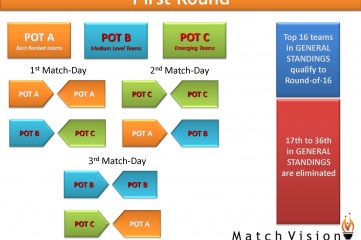Since the original Olympics Games in Ancient Greece, tournament format has remained the same: Round-Robin Groups and Direct Elimination (play-offs). The usage of these formats has caused several issues that organisers have failed to solve.
One major issue is flexibility in the number of participants and matches. Then there is the existence of low-value or “dead” matches, where teams have nothing to play for because they've already qualified for the next round or have been eliminated.
Match-fixing is another problem. In London 2012 for instance, eight female badminton players were disqualified from the tournament due to their attempts to lose their matches on purpose to get an "easier" rival in the next round.
Losing or drawing a match on purpose for the benefit of both sides is something that we see in almost every big tournament. In an attempt to address this issue, matches on the last day of group stages are played simultaneously in many big tournaments, such as the UEFA European Championship and FIFA World Cup. This precautionary move, which followed the "Disgrace of Gijon" in the 1982 FIFA World Cup, can be devastating for fans, sponsors and broadcasters and creates further problems.
Having the last two matches of a group played simultaneously means that two stadiums must be used for each group, so teams must travel from one city to another. In a group of four teams the only way to make teams have the same amount of travels, to ensure fairness, is by making all teams travel twice – that is, playing the first match in one stadium, the second in another and a third stadium for the third match. Having all teams travel once is impossible mathematically, and zero travel is not an option when staging matches simultaneously.
Travelling twice during the group stage can involve a large amount of air travel. For instance, In 2014 FIFA World Cup the United States national team had to travel from Natal to Manaus and then to Recife, a total distance of nearly 6,000 miles.
MatchVision, a company based in Chile, has the solution for this and the associated issue of flexibility in the number of participants in a tournament. In 2003, FIFA expressed an interest in raising the number of participants in the World Cup to 36, but declared it impossible as they couldn't find a fair and simple way to select 16 teams advancing to the Round of 16.
After hearing that declaration, Leandro Shara, MatchVision President and founder, knew he had the solution for it – the POT System ©. Under the POT System © there are no groups; instead, the teams are divided into POTs, depending on the number of matches of the first round.
For instance, a FIFA World Cup with 36 teams would have three POTs, each one containing 12 teams, based on ranking – POT A would have the strongest teams, POT B the medium teams, and POT C the emerging teams. Each team, no matter which POT it is placed in, would play three matches, one against a team from POT A, one against a team from POT B, and one against a team from POT C. For instance, Germany would meet Argentina from POT A, Croatia from POT B and Jordan from POT C. On the other hand, Jordan from POT C would meet Germany (A), as well as Uruguay (B) and Costa-Rica (C).
The POTs are not groups, instead we will have one General Standing of the 36 teams, and after three match days the best 16 would qualify to the next round, fair and simple. Moreover, in the Round of 16 the 1st would face the 16th, the 2nd would face the 15th, etc. That means that teams would want to finish as high as possible to have an "easier" rival in the next match.
This will bring a revolution in the strategy of winning tournaments: the best way would always be, for the first time, to win all matches. It also kills the chances of score manipulations, as teams would not depend just on their match and one additional match (in a four-team group), but on their match and results from the other 17 matches.
Eliminating the possibility of score manipulation would allow all matches in the first round to be played at different times, so spectators around the world could watch all matches live. Additionally, we can ensure that all teams travel exactly once in the first stage and travel the shortest distance from their “home" base. This means that if each host city has another host city within 500 miles or less, than maximum travel for a team would be 500 miles, even if host cities are spread over an entire continent.
The opportunities don't stop there. MatchVision has developed more than 30 solutions giving flexibility to tournaments. So for instance, the Olympic Volleyball competition could have 10 teams instead of 12, with teams still playing five matches in the first round, or to increase the number of teams in the Badminton tournament from 16 to 18, a 12 per cent increase, instead of the usual 50 per cent or 100 per cent increase caused by the rigidity of Groups and Play-Offs formats.
The inflexibility of the traditional tournament formats has created absurd situations, like the ATP World Tour Finals, which is played by eight players, even though the entire world of tennis, including the ATP website itself, talks always about TOP-10. To have a clearer picture of things, the phrase TOP-10 is googled 25 times more than TOP-8. The only reason just 8 players enter the O2 Arena is due to format restrictions, and thus we adjust the reality to the format.
It is time to turn that upside down and adjust format to reality, using tournament formats developed in the 21st century. The format revolution is coming.


